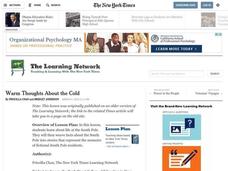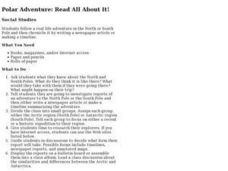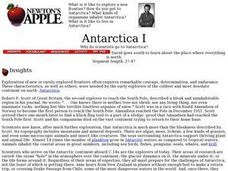Polar Trec
Ozone Data Comparison over the South Pole
Did you know the hole in the ozone is seasonal and filled by January every year? The instructional activity uses scientific measurements of the ozone over the South Pole to understand patterns. Scholars learn that the hole grew bigger...
Curated OER
Warm Thoughts About the Cold
“What do you think life is like at the South Pole?” After responding to this journal prompt, class members read and discuss the New York Times article, “At South Pole, New Home for a New Era.” Using resources available from the Times’...
Curated OER
World Map and Globe-Equator, North Pole, and South Pole
Learners identify the Equator, North Pole, and South Pole on a map. In this geography instructional activity, students use a world map and circle the North and South Pole. Learners locate the Equator on a globe and use a map marker to...
Curated OER
South Pole Base Gamma
Students design a South Pole base. For this science lesson, students discuss characteristics of the South Pole and work in a group to design a base that will be named "Gamma." Students sketch their design.
Curated OER
Polar Explorers-Sir Ernest Shackleton
Young scholars discuss Sir Ernest Shackleton and his participation in the Discovery expedition in 1901 to the South Pole. Students write a persuasive letter of application to an ad Shackleton placed in a London newspaper looking for...
Curated OER
Polar Adventure: Read All About It!
Young scholars investigate reports of an adventure to the North Pole or the South Pole and then chronicle it by writing a newspaper article or making a timeline. The focus is placed on a recent or historic expedition to the region selected.
Polar Trec
Temperature Profile above the South Pole
Collecting and understanding data is a big part of understanding the world and how it changes. To better grasp what temperatures are changing and how they affect global populations, learners create a graph based on the date provided....
Polar Trec
South Pole Ice Cream!
How can you turn an ice cream activity into a scientific investigation? It's easy if you know ionic compounds, heat transfer, and the exothermic and endothermic process. Learners will explore the science behind freezing, insulation, and...
National First Ladies' Library
Brrrr! Expeditions to the North and South Poles
Students examine the first successful explorations of the North and South Poles, through a study of the four men who accomplished them. They present the fruits of their research on posters, or with PowerPoint presentations.
Curated OER
The Magnetometer
Students build an instrument. In this magnetism lesson, students learn about the north and south poles of magnets and build a magnetometer that detects the direction of a magnetic field.
Curated OER
Electricity/Magnetism
Fourth graders explore magnets as fundamental parts of generators and how they are used to produce current electricity. They distinguish between the north and south pole of magnets and the difference between repel and attract. Students...
Curated OER
Terrabagga Activity Using a Magnetometer
Clever! Earth science learners construct a model of a planet containing a magnetic core. The planet, Terrabagga, is made out of a paper grocery bag, magnets, a dead D battery, and rubber bands. Pictures of each step of the construction...
University of Colorado
Terra Bagga
One way to identify possible volcanic activity on other planets is by testing the planet for magnetism. A science lesson begins with pupils constructing their own planet from a dead battery, magnets, paper, and tape before labeling the...
Curated OER
The Magnetometer
Physical or earth science pupils prepare a magnetometer by inducing magnetism into a pair of straight pins. As the pins hang from a thread, they can be used to detect the magnetic field or poles of a magnet. They could also be used as a...
Curated OER
Equator, North Pole, and South Pole
Students identify the Equator, North Pole, and South Pole on the globe. In this map skills lesson, students use a globe marker to locate specific locations on the globe. Students find where they live in relation to the Equator.
Curated OER
World Map and Globe - Four Main Directions
Young scholars study the four main directions on a map. In this map lesson, students locate the North and South pole, and learn the four cardinal directions. They use the compass rose on a map to help with the directions. (Map is not...
Curated OER
United States Map - Lesson 7: Four Main Directions
Students locate the North and South Poles, and learn the definitions of the four directions by using a United States Map and a globe. In this directions lesson plan, students define north, south, east, and west on a map and a globe.
Curated OER
Ozone and Temperature Data Analysis, South Pole Antarctica
Young scholars discuss the layers of the atmosphere, and the history of the ozone hole. They discuss the chemistry of the ozone formation. Students compare seasonal data collected with ozonesondes. They compare Antarctic and Arctic ozone...
SeaWorld
Polar Animals
Young scientists explore some of the scientific equipment that is used by explorers during expeditions to the North or South Pole. Then, they have a relay race! All of the equipment is lined up at a spot 25 yards away from the lines. The...
Curated OER
Main Idea
What could you pack for a trip if you don't know the destination? After writing a list of items they would want to bring, fourth graders learn that the "trip" is to the South Pole - revealing the need to understand all available...
Curated OER
Antarctica I
Students explore exploring and expiditions then simlate their own on campus. They divide into small "expedition groups." Have each team report back to the class about their expeditions, using written, oral, or videotaped presentations.
Curated OER
Grant Proposal
High schoolers experience the creativity, anticipation and peer review of obtaining a grant for scientific research at the poles. They work in cooperative groups to assess the dynamics of polar regions. Each student proposes an original...
Curated OER
Four Main Directions
Students describe directions using a globe for north, east, south and west. In this mapping lesson students identify the north and south pole. Students understand the importance of the equator and the Prime Meridian. Students explain how...
Curated OER
United States Map
Students access prior knowledge and locate the North and South Poles on the map. For this mapping lesson, students understand the position of the United States relative to the poles. Students answer questions about the globe.
Other popular searches
- North Pole South Pole
- Penguins South Pole
- Emperor Penguins South Pole
- North and South Poles
- 90 South Pole
- South Pole Place Near
- Santa in South Pole
- North Pole, South Pole
- The South Pole
- Emperor Penginns South Pole
- North Ans South Poles
- North South Poles

























